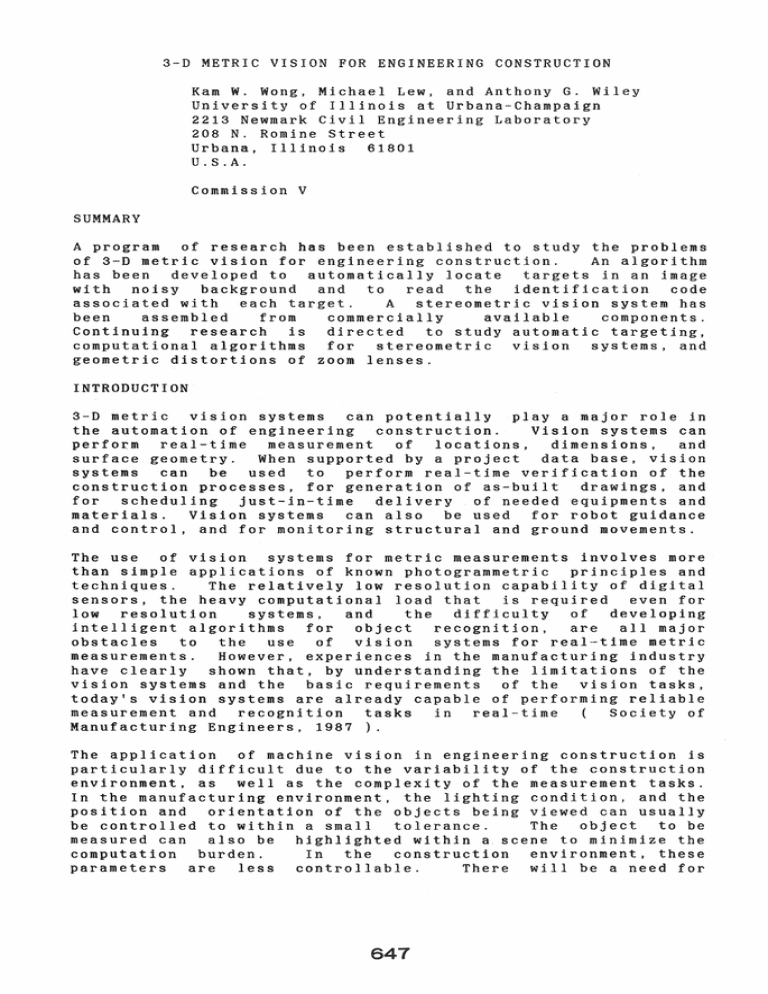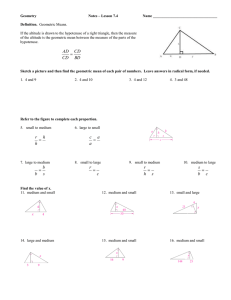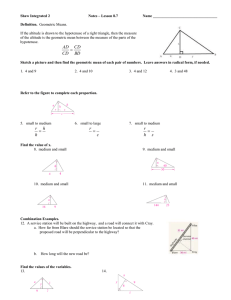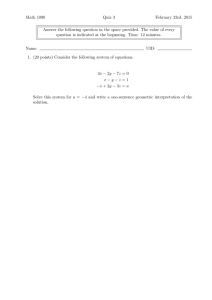3-D METRIC VISION FOR ENGINEERING ... Ram W. Wong, Michael Lew, ...
advertisement

3-D METRIC VISION FOR ENGINEERING CONSTRUCTION Ram W. Wong, Michael Lew, and Anthony G. Wiley University of Illinois at Urbana-Champaign 2213 Newmark Civil Engineering Laboratory 208 N. Romine Street Urbana, Illinois 61801 U.S.A. Commission V SUMMARY A program of research has been established to study the problems of 3-D metric vision for engineering construction. An algorithm has been developed to automatically locate targets in an image with noisy background and to read the identification code associated with each target. A stereometric vision system has been assembled from commercially available components. Continuing research is directed to study automatic targeting, computational algorithms for stereometric vision systems, and geometric distortions of zoom lenses. INTRODUCTION 3-D metric vision systems can potentially playa major role in the automation of engineering construction. Vision systems can perform real-time measurement of locations, dimensions, and surface geometry. When supported by a project data base, vision systems can be used to perform real-time verification of the construction processes, for generation of as-built drawings, and for scheduling just-in-time delivery of needed equipments and materials. Vision systems can also be used for robot guidance and control, and for monitoring structural and ground movements. The use of vision systems for metric measurements involves more than simple applications of known photogrammetric principles and techniques. The relatively low resolution capability of digital sensors, the heavy computational load that is required even for low resolution systems, and the difficulty of developing intelligent algorithms for object recognition. are all major obstacles to the use of vision systems for real-time metric measurements. However, experiences in the manufacturing industry have clearly shown that, by understanding the limitations of the vision systems and the basic requirements of the vision tasks, today's vision systems are already capable of performing reliable measurement and recognition tasks in real-time Society of Manufacturing Engineers, 1987 ). The application of machine vision in engineering construction is particularly difficult due to the variability of the construction environment, as well as the complexity of the measurement tasks. In the manufacturing environment, the lighting condition, and the position and orientation of the objects being viewed can usually be controlled to within a small tolerance. The object to be measured can also be highlighted within a scene to minimize the computation burden. In the construction environment, these parameters are less controllable. There will be a need for algorithms to search an entire scene, under highly variable conditions, in order to identify and measure the locations of targets. The ability of a vision system to zoom in and zoom out on a visual scene will be critical in making full use of its limited resolution. In order to achieve the accuracy requirements of many measurement tasks related to construction, three or more cameras positioned under optimum configurations will often be needed. Then, there will be instances in which stereo vision systems, consisted of two cameras mounted on a fixed base of known length, are needed to provide fast 3-D mapping of the construction scene. This paper reports on an algorithm that is being developed for the automatic identification and location of targets, on the development of a stereo vision system, and on some of the problems associated with geometric distortions. VISION LABORATORY A vision laboratory was established to study the problems of 3-D metric vision in engineering construction. The laboratory is equipped with an International Robomation Intelligence (IRI) DX/VR Vision System, which is a UNIX-based, multi-user program development workstation. The system can acquire images at resolution of 1024x1024, 512x512, or 256x256 pixels. It can distinguish 256 levels of gray, and perform image processing functions on any 256x256 pixel region through windowing. It is equipped with a Motorola MC68010-based host computer, capable of performing about 1 million instructions per second (MIPS). An array processor, capable of performing 50 million arithmetic operations per second (MOPS). is dedicated for feature enhancement, image segmentation, and feature extraction operations. Currently. the system is supported with four General TCZ-200 CeD cameras, each equipped with a 12.5mm-75mm zoom lens; a video graphic hard copier, a graphic printer, and a high resolution color monitor. AUTOMATIC TARGETING The process of automatic targeting consists of three basic steps: 1) search a scene to identify all the survey targets within the field of view, 2) read the identification code associated with each target, and 3) compute the geometric center of each target in the image coordinate system. The process must be robust and accurate. It is a fundamental operation that will be needed for a wide variety of automatic measurement tasks. For example, in the laboratory, a digital camera may be pointed at a three dimensional target field. The vision system then performs automatic targeting and computes all the calibration parameters without human intervention. In the field, automatic targeting may be used for self-orientation of the vision system in the site coordinate system, for 3-D location of survey targets in construction layout, or for monitoring ground and structural stability, An automatic targeting algorithm has been developed, and is being tested using the IRI DX/VR vision system. The algorithm can now identify circular targets and read a bar code for their identification numbers. The following steps are used to identify the circular targets in an image: 1. 2. 3. 4. 5. 6. 7. the image is processed with a median filter to reduce white noise effects; a histogram of the image pixel intensities is calculated, and a threshold is computed at the first local minimum below a predefined intensity level; a binary image is generated using the computed threshold; edge pixels in the image are located by using Robert's gradient; all closed contours from among the edges are identified; the best fitting radius is computed for each closed contour by the least-squares method; accept a closed contour as a target if the mean square error from the least-squares fit is less than a predefined value. Figure 1a to 1d show the basic steps involved. The time required to perform the calculations for the scene illustrated in Figures 1a to ld was about 115 seconds on the IRI DX/VR vision system. Two different bar codes have been developed. In one method, a blank digit denotes zero, and a solid bar denotes the number 1. The present algorithm requires that the bar code identifier be positioned roughly parallel to the row direction of the pixels. See Figure 1a. It must be located at a distance 2R below the center of the circular target, where R is the radius of the target. The bar code must also be bounded within 2R distance to the left and right of the center. The number of digits and their relative positions in the code must be predefined. In the second coding method, a black square is used to represent zero; and a black rectangle is used to represent the number 1. See Figure 2a. An algorithm has been developed to automatically identify this kind of codes from a image, as shown in Figure 2b. The computation procedure is identical to that described above from step 1 to step 5. After all the closed contours in the image have been identified, a cluster analysis is performed to isolate the individual codes. In this manner, a target is first identified in the image by its bar code. The orientation of the code with respect to the row direction of the pixels is not constrained. The exact geometric center of the target can be defined as the centroid of the bar code, or as the centroid of a target such as a circle. located next to the code. This method of target identification is considerably more robust; that is, less liable to making false identification. However, it requires significantly more computational time. For example, it required 350 seconds to identify the three codes shown in Figure 2b. while 115 seconds were needed to identify the targets in Figure 1d. The most important characteristics of algorithms for automatic targeting are robustness, speed, and targeting accuracy. The optimum combination of target shape and identification code must depend on the background noise that varies with the application environment. Continuing efforts are aimed at studying different types of targets and coding methods to develop a better understanding for target design and selection. Figure la. Image Scene With Four Circular Targets Figure lb. Binary Image After Thresholding 650 Figure lc. Edges From The Binary Image Figure ld. Positions of Four Circular Targets Located In Image 651 Figure 2a. An Image With Four Target ID Numbers Represented in Bar Code Figure 2b. Positions of ID Numbers Located In Image 652 STEREOMETRIC VISION SYSTEM Figure 3 shows an experimental stereometric vision system that was built using commercially available components. Each CCD camera is mounted on a micropositioning platform. which permits three translations and three rotations. The translational stages in the x-y ( horizontal) plane have a range of 25mm , and a tracking accuracy of 0.004 mm. The vertical translation stages have a range of 12.5 mm and a positioning accuracy of O.005mm. The x- and y-tilting stages have a range of 3.25 degrees and a positioning accuracy of 20 seconds of arc. The vertical rotational stages have a range of 360 degrees and a reading accuracy of 5 minutes of arc. The two platforms are mounted on a 1-meter optical bar. The distance between the two platforms is adjustable. Each of the two General TCZ-200 eeD cameras is equipped with a 12.5 mm machine vision lens, which provides locking screws for both the focus and aperture settings. Additional pairs of lenses with focal length of 25mm, 50mm, and 75mm are also available. Procedures are being developed for precise alignment of the two focal planes, so that the corresponding rows of pixels in the two focal planes lie in the same epipolar plane (Wong, 1986). The precise alignment will significantly reduce the computation task in performing image correlation. The known relative orientation of the two cameras will also eliminate the need for object space control points in some mapping applications. Algorithms will be developed for stereo mapping to take full advantage of these special characteristics of stereometric vision systems. GEOMETRIC DISTORTIONS There are three primary sources of geometric distortions in a vision system that uses eCD sensors. These are: 1) alignment errors of the pixels in the focal plane, 2) optical distortions of the lenses, and 3) electronic distortions. Alignment errors of the pixels are negligibly small, and can be ignored for all practical purposes. Optical distortions are similar to those encountered in conventional photogrammetry, and can be minimized through lens design or corrected in the computation process. Electronic distortions caused by synchronization errors, voltage fluctuations, quantization of the pixel intensity, and line transmission distortions are extremely difficult to calibrate or to correct in the computation process. Such distortions can be minimized by using a digital sensor that converts the intensity signal from each pixel directly to digital form in the camera, as suggested by Dahler (1987). Commonly available eeD cameras are designed for television applications, and the output image is an analog signal, which needs to be converted to digital form. Perfect synchronization between signal generation and the digitizing process is needed to avoid geometric distortions. Figure 4 shows a large, visible, distortion of a vertical line at the top of the image. The distortion was found to be caused by a defective cable that carries the synchronization signal between the eCD camera and the image digitizer. While large electronic distortions such as that shown in Figure 4 can exists, good 653 Figure 3. An Experimental Stereometric Vision System Figure 4. Geometric Distortion Caused By A Defective Syn Cable 654 quality CCD vision systems are usually well manufactured. With a moderate degree of efforts devoted to geometric calibration, measurement accuracy in the order of ~ 0.25 pixel is achievable (Curry et aI, 1986; EI-Hakim, 1986; Luhmann and WesterEbbinghaus. 1987). Thus, for a pixel dimension of 0.015 mm, a measurement accuracy of ~ 0.004mm on the focal plane can be expected. For a focal length of 12.5mm. 50mm, and 75mm, an accuracy of ~ 0.004 mm on the focal plane would correspond to a directional accuracy of + 60, 15, and 10 seconds of arc respectively. Such levels of accuracy are acceptable in many measurement problems commonly encountered in engineering construction. Zoom lenses, under the motorized control of the vision system. provide one possible method of making full use of the limited resolution capability of CCD sensors. However, the magnitude and pattern of geometric distortion will change with changes in focal length setting. Distortion correction during measurement can be facilitated if mathematical models can be developed to represent these changing distortion characteristics. Experimental studies are being conducted to study the geometric distortion characteristics of zoom lenses. CONCLUSION Vision systems provide the opportunity to perform engineering measurements in real time. and in a fully automated mode. However, full automation will require that a vision system possesses some human-like skills such as feature recognition, communication with project data bases, data analysis and verification, and decision making. The most challenging problem, therefore, will be the development of computer algorithms to perform the basic functions that are now routinely performed by an experienced photogrammetrist. ACKNOWLEDGEMENT The research reported in this paper was conducted as part of the University of Illinois Advanced Construction Technology Center research program sponsored by the U.S. Army Research Office under the DOD-University Research Initiative Program. The authors acknowledge and appreciate the supports of Dr. J. P. Murtha, Director of the Center. REFERENCES Curry, Sean. Sheldon Baumrind, and J. M. Anderson. Calibration of An Array Camera. Photogrammetric Engineering and Remote Sensing, vol. 52, no. 5, pp. 627-636, 1986. Dahler, J. Problems in Digital Image Acquisition with CCD Cameras. Proceedings of ISPRS Intercommission Conference on Fast Processing of Photogrammetrlc Data, Interlaken, June 2-4, pp. 4859, 1987. EI-Hakim, S.F. Image Metrology with CCD Cameras. Real-Time Photogrammetric Engineering and Remote Sensing, vol. 52, no.l1, pp. 1757-1766, 1986. Luhmann, Thomas, and Wilfried Wester-Ebbinghaus. On Geometric Calibration of Digitized Video Images of CCD Arrays. Proceedings of ISPRS Intercommission Conference on Fast Processing of Photogrammetric Data, Interlaken. June 2-4, pp. 35-47, 1987. Society of Proceedings, Manufacturing Engineers, Vision '87, Dearborn, Michigan, June 8-11, 1987. Wong, R.W. Real-Time Machine Vision Systems. Surveyor, vol. 41, no. 2, pp. 173-180, 1987. 656 Conference The Canadian




